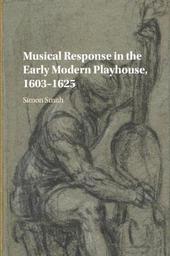
|
Musical Response in the Early Modern Playhouse, 1603-1625
Paperback / softback
Main Details
| Title |
Musical Response in the Early Modern Playhouse, 1603-1625
|
| Authors and Contributors |
By (author) Simon Smith
|
| Physical Properties |
| Format:Paperback / softback | | Pages:262 | | Dimensions(mm): Height 226,Width 154 |
|
| Category/Genre | Drama
Baroque music (c 1600 to c 1750) |
|---|
| ISBN/Barcode |
9781316632369
|
| Classifications | Dewey:822.309 |
|---|
| Audience | | Professional & Vocational | |
|---|
| Illustrations |
Worked examples or Exercises; 2 Printed music items; 10 Halftones, black and white
|
|
Publishing Details |
| Publisher |
Cambridge University Press
|
| Imprint |
Cambridge University Press
|
| Publication Date |
13 September 2018 |
| Publication Country |
United Kingdom
|
Description
Presupposing no specialist musical knowledge, this book offers a fresh perspective on the dramatic role of music in the plays of Shakespeare and his early seventeenth-century contemporaries. Simon Smith argues that many plays used music as a dramatic tool, inviting culturally familiar responses to music from playgoers. Music cues regularly encouraged audiences to listen, look, imagine or remember at dramatically critical moments, shaping meaning in plays from The Winter's Tale to A Game at Chess, and making theatregoers active and playful participants in playhouse performance. Drawing upon sensory studies, theatre history, material texts, musicology and close reading, Smith argues for the importance of music in familiar and less well-known plays including Antony and Cleopatra, Othello, The Revenger's Tragedy, Sophonisba, The Spanish Gypsy and A Woman Killed With Kindness.
Author Biography
Simon Smith is Leverhulme Early Career Fellow at the Shakespeare Institute, Stratford-upon-Avon and the Department of English Literature, University of Birmingham. He has published widely on music in Shakespeare and early modern drama, and co-edited The Senses in Early Modern England, 1558-1660 (with Jackie Watson and Amy Kenny, 2015). His theatre-historical research informed the design of the Sam Wanamaker Playhouse at Shakespeare's Globe and he has provided historical music research - and occasionally musical direction - for many productions including Twelfth Night and Richard III at Shakespeare's Globe in 2012, The Tragedie of Cleopatra in 2013 at University College London and Wolf Hall on the BBC in 2015.
Reviews'With his announced focus on 'response' Smith makes a genuinely fresh and provocative contribution to the study of early modern theatre in England and, I would argue, to sound studies and musicology. This is the perfect moment for Smith's book to be published. It will find readers among younger, boundary-changing scholars in sound-based disciplines as well as among students of Shakespeare and early modern drama.' Bruce Smith, University of Southern California 'Music will no longer be conceived as somehow a pleasant interlude within a play's dramatic action. Simon's rich examination has much to say about the way we attempt to understand the period's performance and theatre. ... It is fitting that a study about music in plays attains such a happy concord of substance and style.' Tom Healy, University of Sussex 'Simon Smith has written an elegantly structured book, drawing its examples from a wide range of theatrical and musical sources. There are already several books on music in Renaissance drama, but he has found what I think is a new approach in his analysis of how music was thought of, in both theoretical and popular terms, and how audiences, offstage and on, respond to it.' Lois Potter, University of Delaware 'This book is highly original in several ways ... [it] will be an essential reference for further work on music within early modern drama and for future accounts of musical affect in the period. It will also be essential reading for those working in interdisciplinary literature and music studies or the wider field of sound studies, both of them currently expanding fields of scholarship.' University English Book Prize Report
|